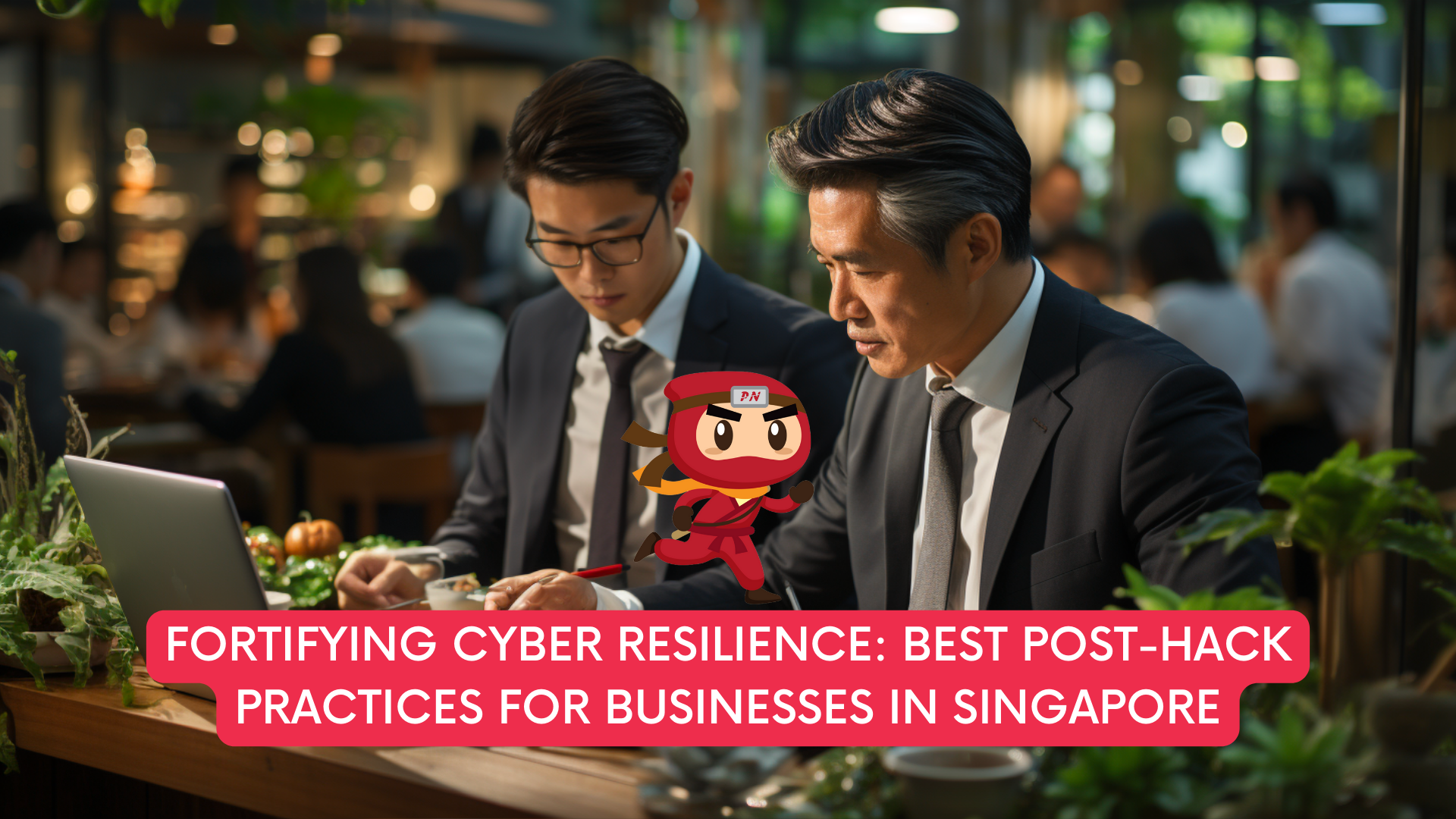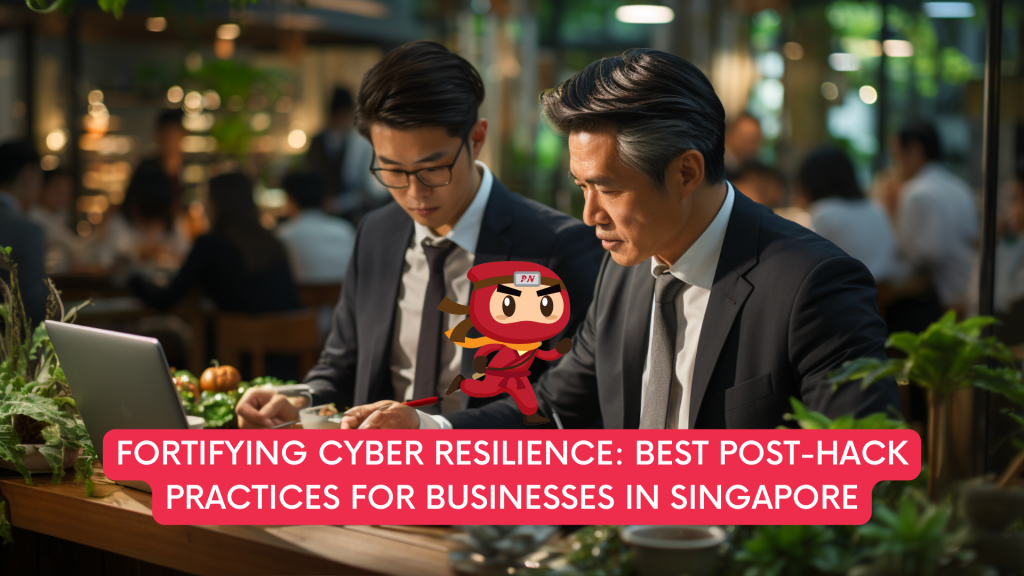KEEP IN TOUCH
Subscribe to our mailing list to get free tips on Data Protection and Cybersecurity updates weekly!







In an increasingly digitalized world, businesses in Singapore face ever-mounting cyber threats. Despite investing in robust cybersecurity measures, no organisation is entirely immune to a cyberattack. In the aftermath of a hack, how businesses respond can significantly impact their ability to recover swiftly and minimise damages.
This article outlines the best post-hack practices for businesses in Singapore, empowering them to strengthen their cyber resilience and protect their reputation, customer trust, and sensitive data.
1.1. Upon discovering a breach, businesses must swiftly contain the incident to prevent further damage. The first step is to isolate affected systems and disconnect them from the network to stop the spread of malware or unauthorised access.
1.2. Having an incident response plan in place, with predefined roles and responsibilities, enables the organisation to respond effectively, minimising the potential impact of the attack. This plan should include the contact information of key personnel and external cybersecurity experts who can assist in handling the incident.
2.1. Reporting the breach to the Singaporean authorities, such as the Cyber Security Agency of Singapore (CSA), is a critical step in the post-hack process. By doing so, businesses can receive expert guidance, cooperate with investigations, and comply with legal obligations.
2.2. Collaborating with law enforcement can also help identify and apprehend the attackers, contributing to the broader cybersecurity landscape by disrupting cybercriminal networks.
3.1. After containing the attack, it is essential to conduct a comprehensive post-incident analysis. This examination allows businesses to understand the attack vectors, the extent of the breach, and the potential data compromised.
3.2. Identifying the root cause of the breach is vital for making informed decisions on future security improvements and preventing similar incidents. Organizations should review their existing security measures, protocols, and configurations to identify weaknesses and vulnerabilities that may have been exploited.
4.1. Transparency is crucial in maintaining trust with customers, partners, and stakeholders. Once the scope of the breach is understood, businesses should promptly notify affected parties about the incident, the data exposed, and the measures being taken to address the issue.
4.2. Open communication builds goodwill and demonstrates the organization’s commitment to resolving the situation. Timely and transparent communication can also help affected individuals take appropriate measures to protect themselves, such as changing passwords or monitoring financial accounts for suspicious activity.
5.1. Many hacks result from weak authentication practices and insufficient access controls. Post-hack, businesses in Singapore should reinforce their security measures by implementing multi-factor authentication (MFA) for user accounts and enforcing the principle of least privilege.
5.2. Regularly reviewing user access permissions can prevent unauthorized access in the future. Additionally, implementing strong password policies and educating users on creating unique and complex passwords is essential.
6.1. Encrypting sensitive data both in transit and at rest is a crucial safeguard against unauthorized access. Encryption ensures that even if data is intercepted during transmission or stolen, it remains unreadable and unusable without the decryption key.
6.2. Additionally, tokenization, where sensitive data is replaced with unique tokens, further reduces the risk of data exposure during a breach. Tokenization ensures that even if attackers gain access to the tokenized data, it cannot be linked back to the original sensitive information.

7.1. Backing up critical data on a regular basis is a fundamental security measure that can save a business from devastating data loss during a hack. Adopting a robust data backup strategy, including off-site storage, ensures that even in the worst-case scenario, essential information can be recovered.
7.2. Periodic testing of data backups verifies their integrity and ensures a reliable disaster recovery process. Businesses should conduct restoration tests to confirm that backed-up data can be successfully retrieved and restored when needed.
8.1. Human error remains a significant factor in successful cyberattacks. Businesses should invest in ongoing cybersecurity awareness training for all employees, educating them on common cyber threats, phishing scams, and social engineering techniques.
8.2. Well-informed employees become an essential line of defense against potential breaches. Training should also include information about the latest attack trends and best practices for identifying and reporting suspicious activities.
9.1. Incorporating advanced network security solutions, such as intrusion detection systems (IDS) and intrusion prevention systems (IPS), fortifies the organisation’s cyber defences. These systems can detect and block suspicious network activity and prevent unauthorised access attempts.
9.2. Similarly, deploying robust endpoint protection software shields devices from malware and malicious activities, reducing the risk of breaches originating from compromised endpoints.
10.1. Engaging external cybersecurity experts can provide invaluable insights into the organisation’s security posture and vulnerabilities. Third-party experts can conduct regular penetration testing and security assessments to identify weak points before malicious actors exploit them.
10.2. They can also offer guidance on implementing industry best practices and the latest security technologies to strengthen the organization’s overall cybersecurity framework.

With cyber threats becoming more sophisticated, businesses in Singapore must acknowledge the importance of preparedness in the face of a cyberattack. By implementing the best post-hack practices outlined in this article, organizations can enhance their cyber resilience, protect their critical assets, and regain customer trust swiftly.
A proactive and comprehensive approach to cybersecurity, coupled with ongoing employee training and external expertise, will empower businesses to navigate the evolving threat landscape with confidence and resilience. Embracing these practices and continuously adapting to emerging threats will ensure that businesses in Singapore remain at the forefront of cyber defense in an increasingly digital and interconnected world.
Your appointed DPO can work with you on your PDPA compliance, ensuring that there will be policies in place to make sure that the handling of personal data is PDPA compliant.
A Data Protection Officer (DPO) oversees data protection responsibilities and ensures that organisations comply with the Personal Data Protection Act (PDPA). Furthermore, every Organization’s DPO should be able to curb any instances of PDPA noncompliance as it is the officer responsible for maintaining the positive posture of an organisation’s cybersecurity.
DPOs complement organisations’ efforts to ensure that the organisation’s methods of collecting personal data comply with the PDPA. It also ensures that policies are set in place to make sure that there will be no instances of data breaches in the future.
Don’t wait any longer to ensure your organisation is PDPA compliant. Take our free 3-minute PDPA Compliance Self-audit checklist now, the same “secret weapon” used by our clients to keep them on track. Upon completion, we will send you the results so you can take the necessary action to protect your customers’ data. Complete the free assessment checklist today and take the first step towards protecting your customers’ personal data.